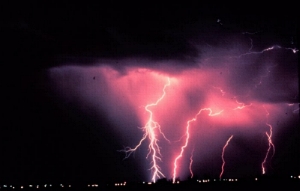What is lightning?
Lightning is a bright flash of electricity produced by a thunderstorm. All thunderstorms produce lightning and are very dangerous. If you hear the sound of thunder, then you are in danger from lightning. Lightning kills and injures more people each year than hurricanes or tornadoes; between 75 to 100 people.

What causes lightning?
Lightning is an electric current. Within a thundercloud way up in the sky, many small bits of ice (frozen raindrops) bump into each other as they move around in the air. All of those collisions create an electric charge. After a while, the whole cloud fills up with electrical charges. The positive charges or protons form at the top of the cloud and the negative charges or electrons form at the bottom of the cloud. Since opposites attract, that causes a positive charge to build up on the ground beneath the cloud. The grounds electrical charge concentrates around anything that sticks up, such as mountains, people, or single trees. The charge coming up from these points eventually connects with a charge reaching down from the clouds and - zap - lightning strikes!

Have you ever rubbed your feet across carpet and then touched a metal door handle? If so, then you know that you can get shocked! Lightning works in the same way.

Click Here to see where lightning is currently striking across the U.S.
How hot is lightning?
Lightning is approximately 54,000 degrees Fahrenheit. That is six times hotter than the surface of the sun!
What color is lightning?
Lightning seems to be clear or a white-yellow color, but it really depends on the background.

What causes thunder?
Thunder is caused by lightning. When a lightning bolt travels from the cloud to the ground it actually opens up a little hole in the air, called a channel. Once then light is gone the air collapses back in and creates a sound wave that we hear as thunder. The reason we see lightning before we hear thunder is because light travels faster than sound!
How do you know if lightning is nearby?
If you see dark clouds, then lightning could be present, but the best thing you can do is to listen for thunder. If you hear thunder, then you need to go indoors or get in a car. Don't be outside, where lightning could strike! If your hair stands on end or your skin starts to tingle, lightning maybe about to strike. Get down on your hands and knees and keep your head tucked in. Do not lay flat, because it can give lightning a better chance of strike you.

How far away can you see lightning and hear thunder?
Within those distant thunderstorms, the lightning bolts can be seen as much as 100 miles from us, depending on the height of the bolt, the clarity of the air, and our elevation. Thunder, in comparison, has a much shorter range of detection - usually less than 15 miles in a quiet rural setting and under 5 miles in a noisy city environment.
Why are you less likely to see static electricity in the summer?
In the summer, our dew points are much higher due to warm and humid air coming from the Gulf of Mexico and that is why we have humid weather. In the winter, our dew points are much lower due to cold and direr air coming from Canada. The lower the dew point the better it is to create static electricity, so that's why you see it more in the winter.
What is cloud-to-ground lightning?
All lightning is dangerous, but cloud-to-ground lightning is the most dangerous type of lightning. Most cloud-to-ground lightning strikes come from the negatively charged bottom of the cloud traveling to the positively charged ground below.
Cloud-to-ground lightning bolts strike the tall objects, like trees and buildings. These lightning strikes can cause fire and property damage. If you're the tallest object, then lighting can strike you. Lightning is the second weather related killed.
What is intracloud lightning?
Intracloud lightning is the most common type of lightning. This occurs when there are both positive and negative charges within the same cloud. Usually, the process takes place within the cloud and looks like a bright flash of light which flickers.
What is intercloud lightning?
Intercloud lightning is less common. It's when a lightning strike occurs when there are positive and negative charges within different clouds and the strike travels in the air between them.
What is forked lightning?
Forked lighting appears as jagged lines of light. They can have several branches. Forked lightning can be seen shooting from the clouds to the ground, from one cloud to another cloud, or from a cloud out into the air. This lightning can strike up to 10 miles away from a thunderstorm.

What is sheet lightning?
Sheet lightning appears as flashes of light that seem to light up or illuminate entire clouds.
What is heat lightning?
Heat lightning is a term used to describe lightning flashes that are too far away from you to hear the thunder. The reason that it is called heat lightning is that it appears most often on a hot summer day when the sky is clear overhead.
What is high-altitude lightning?
High-altitude lightning has been given other names such as "red sprites," "green elves," and "blue jets." This form of lightning appears as brightly colored flashes, high above thunderstorms. You can't see these types of lightning from the ground.
What is ribbon lightning?
Ribbon lightning is when a bolt of lightning separates due to wind and appears as parallel lightning streaks.
What is chain or bead lightning?
Chain or bead lightning is when a lightning bolt is broken into dotted lines while fading.
What is ball lightning?
Ball lightning is a rare form of lightning. It usually appears as a reddish, luminous ball, but can come in any color. Ball lightning is usually spherical in shape and about one foot in diameter. Hissing noises originate from such balls and they sometimes make a loud noise when they explode.

What is St. Elmo's Fire?
St. Elmo's Fire appears as a blue or greenish glow above pointed objects on the ground. It is created when tiny positively charged sparks reach up in response to negatively charges in the air or clouds above the ground. If a thunderstorm is nearby, St. Elmo's Fire might be seen right before a lightning strike.
What is anvil lightning?
Anvil lightning is a type of lightning referred to as "the bolt from the blue" because it often appears suddenly from a seemingly cloudless sky. A bolt at the top of a thunderstorm arcs away from the main cloud and strikes the ground where the skies above often appear clear.
Can you tell how far away a storm is?
Yes, you can use thunder to tell how far away a storm is. Next time you see a storm, count the number of seconds between when you see the lightning and hear the thunder. Take the number of seconds and divide by 5 and that will tell you how far away the storm is in miles. For example: If you counted 10 seconds between the lightning and the thunder, the lightning is 2 miles away!
SEVERE THUNDERSTORM WATCH - A severe thunderstorm (damaging winds of 58 miles per hour or more, or 1" hail in diameter or greater) is likely to develop in your area.
SEVERE THUNDERSTORM WARNING - A severe thunderstorm (damaging winds of 58 miles per hour or more, or hail three-fourths of an inch in diameter or greater) is taking place in your area.
PROTONS - They are particles with a positive charge.
ELECTRONS - They are particles with a negative charge.
STATIC ELECTRICITY - It is a form of electricity that is created when an object has too many electrons, giving it a negative charge.
LEADERS - A channel of charged air created by excess electrons in a thunderstorm cloud. A leader reaches from the cloud to the ground below, looking for positive charges.
RETURN STROKE - It's an electrical charge that travels from the ground to a thundercloud. This return stroke releases tremendous energy, bright light and thunder.
STREAMERS - A channel of charged air created by protons on the ground. They are created when leaders are created and reach from the ground to the sky looking for a leader to connect with.
Click Here to see if there are any active warnings in your area.
 Lightning Safety Tips
Lightning Safety Tips
IF YOU’RE OUTDOORS: Keep an eye at the sky. Look for darkening skies, flashes of lightning, or increasing winds. Lightning often proceeds rain, so don’t wait for the rain to begin. If you hear the sound of thunder, go to a safe place immediately. The best place to go is a sturdy building or a car, but make sure the windows in the car are shut. Avoid sheds, picnic areas, baseball dugouts and bleachers. If there is no shelter around you, stay away from trees. Crouch down in the open area, keeping twice as far away from a tree as far as it is tall. Put your feet together and place your hands over your ears to minimize hearing damage from thunder. If you’re with a group of people stay about 15 feet from each other. Stay out of water, because it’s a great conductor of electricity. Swimming, wading, snorkeling and scuba diving are not safe. Also, don’t stand in puddles and avoid metal. Stay away from clotheslines, fences, and drop your backpacks because they often have metal on them. If you’re playing an outdoor activity, wait at least 30 minutes after the last observed lightning strike or thunder.
IF YOU’RE INDOORS: Avoid water. It’s a great conductor of electricity, so do not take a shower, wash your hands, wash dishes or do laundry. Do not use a corded telephone. Lightning may strike exterior phone lines. Do not use electric equipment like computers and appliances during a storm. Stay away from windows and doors and stay off porches.
IF SOMEONE IS STRUCK BY LIGHTNING: Call for help. Call 9-1-1 or send for help immediately. The injured person does not carry an electrical charge, so it is okay to touch them.
 Lightning Activities
Lightning Activities
Lightning Experiment: Here is a great experiment that allows kids to make lightning in their mouth. It's a great way for them to understand how lightning works.
Lightning Experiment: Here is a great experiment that allows the kids to make lightning. All you need is a balloon and a light bulb!
Lightning Experiment: Here is another great experiment that allows the kids to make lightning. This teaches kids about the positive and negative charges and where they come from.
Static Electricity Experiment: Here is an experiment that allows the kids to learn about static electricity by sticking a balloon to a wall. This teaches kids about the positive and negative charges and where they come from.
Static Electricity Experiment: Here is another static electricity experiment that bends water. This teaches kids about the positive and negative charges and where they come from.
Static Electricity Experiment: Here is yet another static electricity experiment with using a balloon and your hair. This teaches kids about the positive and negative charges and where they come from.
Thunder Experiment: This experiment allows kids to make thunder, in a way that allows them to understand how it is made by lightning.
Thunderstorm Experiment: Here is a great way to teach kids how to track a thunderstorm.
Thunderstorm Experiment: Here is a great experiment that shows kids how our weather works. It teaches them how thunderstorms are formed!
Science Fair Project Ideas: Here is a complete list of science fair project ideas. Discover the science behind the weather that impacts us every day.